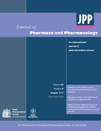Biological activity of the essential oil of Kadsura longipedunculata (Schisandraceae) and its major components
Abstract
Objectives The aim was to determine the chemical composition of the essential oil of Kadsura longipedunculata and the biological activity of the oil and its major components.
Methods The essential oil from stem bark of Kadsura longipedunculata was analysed by capillary gas chromatography (GLC/FID) and gas chromatography–mass spectrometry (GLC/MS). The ability of the oil to reduce diphenylpicrylhydrazine (DPPH•) was used to evaluate the antioxidant activity. Inhibition of both lipoxygenase and prostaglandin E2 was used to assess the anti-inflammatory activity. Antimicrobial activity was studied in vitro against a range of bacteria and fungi using diffusion and microdilution methods. Inhibition of trypanosome proliferation was assessed using resazurin as vital stain. The in-vitro cytotoxicity of the essential oil on six human cancer cell lines (HepG2, MIA PaCa-2, HeLa, HL-60, MDA-MB-231 and SW-480) was examined using the MTT assay.
Key findings Fifty compounds, representing 97.63% of total oil, were identified. δ-Cadinene (21.79%), camphene (7.27%), borneol (6.05%), cubenol (5.12%) and δ-cadinol (5.11%) were found to be the major components of the oil. The oil exerted a good antimicrobial activity against all Gram-positive bacteria tested, including methicillin-resistant Staphylococcus aureus and vancomycin-resistant Enterococcus faecalis. Streptococcus pyogenes and S. agalactiae were the most sensitive bacteria with a minimal inhibitory concentration (MIC) of 60 µg/ml oil. The essential oil showed a moderate fungicidal activity against yeasts, but it did not show any activity against Gram-negative bacteria. The essential oil showed a good trypanocidal activity in Trypanosoma b. brucei with an IC50 value of 50.52 ± 0.029 µg/ml. Radical scavenging activity had an IC50 value of 3.06 ± 0.79 mg/ml. 5-Lipoxygenase inhibition (IC50 = 38.58 µg/ml) and prostaglandin E2 production inhibition (28.82% at 25 µg/ml) accounted for anti-inflammatory activity of the oil. The oil exhibited some degree of cytotoxic activity against MIA PaCa-2, HepG-2 and SW-480 cell lines with IC50 values of 133.53, 136.96 and 136.62 µg/ml, respectively. The oil increased caspase 3/7 activity (an indicator of apoptosis) 2.5–4 fold in MIA Paca-2 cells. Camphene and borneol did not show antioxidant activity. However, both compounds exhibited some degree of antimicrobial, trypanocidal, anti-inflammatory and cytotoxic activity.
Conclusions This investigation provided evidence for, and confirmed the efficacy of, K. longipedunculata, a traditionally used Chinese medicinal plant for the treatment of inflammation and infection.




